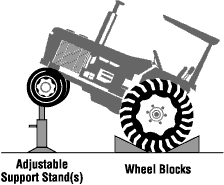Tractors – Maintenance Fact Sheet
WHAT ARE SOME SAFETY TIPS TO KNOW WHEN WORKING ON A TRACTOR?
- Read, understand, and follow the instructions in the manufacturer’s maintenance manual.
- Disengage power, lower hydraulics and stop the engine before doing any maintenance.
- Remove ignition key.
- Disconnect batteries before doing any electrical work.
- Support equipment on blocks or stands. Do not rely on hydraulic hoists or cylinders. They are designed for lifting only and can fail without warning.

- Provide adequate ventilation when running an engine indoors. Engine exhaust fumes contain carbon monoxide–a colourless, odourless and deadly gas.
- Use appropriate tools. Tractor maintenance requires wrenches and other tools that may be larger in size than those used for automobiles.
- Protect yourself from sharp edges and protruding parts. Wear gloves and cover sharp edges with tape or guards.
- Keep all guards in place. Replace damaged or missing guards or shields.
- Keep hands, feet and clothing away from moving parts.
- Adjust right and left brakes so they are equal on the rear wheels.
- Check steering and control mechanisms, warning devices, lights and governors.
- Keep work area clean and well lit.
- Clean up spilled oil, grease or hydraulic fluid immediately.
- Remove all tools and parts before starting the engine.
- Do not start the engine, engage power or raise or lower an implement without warning other people in the area.
- Follow manufacturer’s guidelines for maintenance and repair. Keep a log of all service and maintenance.
What are some safety tips for working with hydraulics?
Improperly maintained or adjusted parts can cause serious injury.
Always use caution when working on a hydraulic system. Even when the system is shut down, hydraulic oil can still be under very high pressure.
Before Servicing:
- Lower hydraulic-powered equipment to the ground or block mechanically.
- Shut off the engine which powers the hydraulic pump.
- Move the hydraulic lever back and forth a few times to release pressure.
- Let hydraulic system cool down.
- Follow manufacturer’s instructions. Servicing procedures vary from one hydraulic system to another.
- Hydraulic fluid escaping through pinhole leaks is difficult to see but its high pressure can puncture the skin. Have a physician treat any hydraulic fluid skin punctures immediately.


- Check for leaks by passing a piece of cardboard or wood over the suspected area.
- Relieve the pressure and replace the defective part.